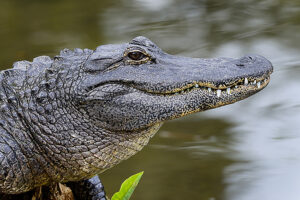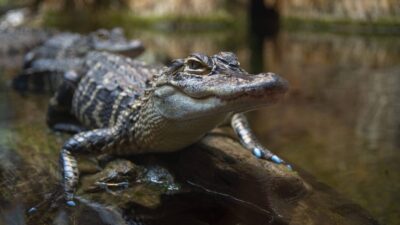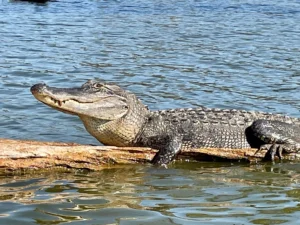Animals similar to alligators showcase a fascinating diversity in the animal kingdom. From the formidable crocodiles to the elusive caimans, these creatures share common traits that make them captivating members of the reptilian family.
With their scaly armor, powerful jaws, and semi-aquatic lifestyle, these animals have adapted to various environments, proving their resilience in both water and on land. Join me on a journey to explore the captivating world of creatures akin to alligators, where survival instincts and ancient lineage converge in the realm of wild wonders.
Understanding alligators

Alligators are large, semi-aquatic reptiles belonging to the family Alligatoridae, which also includes caimans. There are two species of alligators: the American alligator (Alligator mississippiensis) and the Chinese alligator (Alligator sinensis).
Here are some key points to help you understand alligators better:
- Habitat: Alligators are primarily found in freshwater habitats such as swamps, lakes, rivers, and marshes. They are well-adapted to both aquatic and terrestrial environments.
- Geographical Distribution:
- American Alligator: Native to the southeastern United States, the American alligator is found in states such as Florida, Louisiana, Georgia, Alabama, Mississippi, North and South Carolina, Texas, and parts of Oklahoma.
- Chinese Alligator: This species is native to eastern China, particularly in the Yangtze River region. Chinese alligators are much smaller than their American counterparts.
- Physical Characteristics:
- Alligators have a robust and armored body with a large, broad head.
- Their skin is covered in bony plates called osteoderms or scutes, which provide protection.
- Alligators have a powerful tail that aids in swimming and propulsion through the water.
- Diet: Alligators are carnivorous predators. Their diet includes fish, turtles, birds, mammals, and occasionally smaller alligators. They are opportunistic feeders and will consume whatever prey is available.
- Behavior:
- Alligators are known for their powerful jaws and a bite force that can crush bones.
- They are cold-blooded, relying on external sources of heat to regulate their body temperature.
- Alligators are proficient swimmers and can move quickly in the water. Despite their size, they are surprisingly agile.
- Reproduction:
- Female alligators build nests of vegetation and mud in which they lay eggs.
- The sex of the offspring is determined by the temperature during incubation, with higher temperatures producing males and lower temperatures producing females.
- Mother alligators are protective of their nests and young.
- Conservation Status:
- The American alligator has rebounded from near extinction in the mid-20th century and is currently listed as a species of “Least Concern” by the International Union for Conservation of Nature (IUCN).
- The Chinese alligator, on the other hand, is considered critically endangered, with only a small population remaining in the wild.
Understanding alligators involves appreciating their ecological role as top predators in their habitats and recognizing the importance of conservation efforts to ensure their survival.
Alligator Conservation
Conservation efforts for alligators focus on preserving their natural habitats, managing human-alligator conflicts, and implementing regulations to ensure sustainable populations. Here are key aspects of alligator conservation:
- Habitat Protection:
- Preserving natural wetland habitats is crucial for the survival of alligators. Wetlands provide the necessary conditions for breeding, feeding, and shelter.
- Efforts are made to protect and restore wetland ecosystems, including the enforcement of regulations that prevent habitat destruction.
- Regulations and Management:
- Strict regulations govern the hunting and harvesting of alligators to prevent overexploitation. Many regions have established hunting seasons, bag limits, and size restrictions to ensure sustainable populations.
- Wildlife management agencies monitor alligator populations, conduct research, and adjust regulations as needed to maintain ecological balance.
- Public Education and Outreach:
- Public awareness programs help educate communities about the importance of alligators in ecosystems and the need for conservation.
- Informing the public about the behavior of alligators and how to coexist with them helps reduce human-alligator conflicts.
- Research and Monitoring:
- Ongoing research is conducted to better understand alligator biology, behavior, and population dynamics.
- Monitoring programs track alligator populations, reproductive success, and habitat health to identify potential issues and inform conservation strategies.
- Mitigation of Human-Alligator Conflicts:
- Alligators sometimes come into contact with human populations, leading to potential conflicts. Efforts are made to manage these situations through relocation, habitat modification, and public education.
- Encouraging responsible behavior, such as not feeding wild alligators, helps minimize interactions and conflicts.
- Captive Breeding and Reintroduction:
- Captive breeding programs, particularly for the critically endangered Chinese alligator, aim to increase population numbers for potential reintroduction into the wild.
- Reintroduction efforts are carefully planned to ensure the success of released individuals in their natural habitats.
- International Collaboration:
- Alligator conservation often involves collaboration between countries, especially for species like the Chinese alligator that are found in specific regions.
- International agreements and partnerships support coordinated efforts to protect alligator populations and their habitats.
- Climate Change Considerations:
- Climate change can impact alligator habitats, affecting temperature-dependent sex determination during egg incubation and altering water levels. Conservation strategies need to consider these potential impacts and adapt accordingly.
Conserving alligators is not only essential for maintaining biodiversity but also contributes to the health of wetland ecosystems. By protecting these reptiles and their habitats, conservation efforts benefit a wide range of plant and animal species that share the same ecosystems.
30 animals similar to alligators



